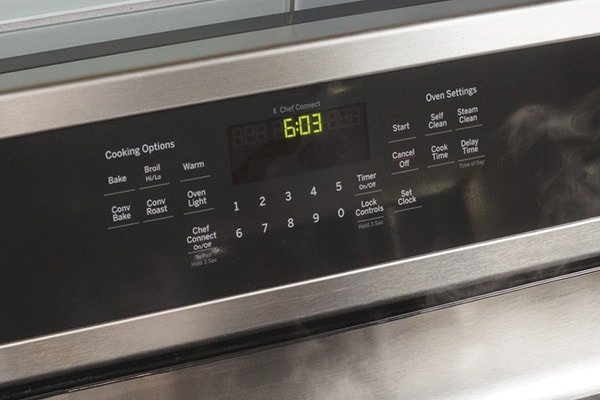
The F2 error code on GE ovens usually indicates a temperature issue, often relating to the oven’s temperature sensor or the oven’s control board. Imagine the sensor as the oven’s thermometer, keeping tabs on the temperature. If the sensor sends an abnormal signal, or if the control board misinterprets it, you get the F2 error. Initially, this can seem daunting, but there might be a straightforward solution. You might be thinking, “Can I just reset my oven to clear this up?” Well, the short answer is: it depends.
Understanding the F2 Error: What’s the Cause?
The F2 error code is often linked to temperature regulation issues. Picture this: you set your oven to bake a cake at 350°F. The oven’s temperature sensor is like a vigilant guard, ensuring the temperature stays around that mark. However, if the sensor reports an unusually high temperature, the oven assumes something’s wrong and displays the dreaded F2 code. This is like your car’s engine light flicking on when it detects a problem.
Why does this happen? It could be due to a faulty temperature sensor, a malfunctioning control board, or, in some cases, a simple electrical glitch. The sensor might become erratic over time, or the connections may loosen, leading to incorrect readings. Sometimes, grease or grime buildup can even cause interference. It’s helpful to consider a reset as a first try, but it’s essential to know that a reset may not solve underlying hardware issues.
If the F2 error keeps popping up, it might be time to dig deeper. Look at it as a signal to inspect your oven’s components. Simply resetting the appliance won’t fix a genuinely broken sensor. In such cases, replacing the sensor or repairing the control board might be necessary. For a beginner, this might seem overwhelming, so having a technician check the components could save you a lot of headaches.
Can Resetting Your Oven Solve the Problem?
Here’s the deal: resetting your oven is like rebooting your computer when it freezes on you. It’s a quick and easy step that might clear temporary glitches. To reset your GE oven, simply unplug it from the power source, wait for about a minute, and plug it back in. This process gives the appliance a clean slate to work from and can sometimes make those pesky error codes disappear.
You might be wondering, why does this work? Well, sometimes the control board can get confused due to a power surge or irregularities in the power supply. A reset clears the board’s memory and starts fresh. However, if the F2 error is indeed due to a deeper mechanical or sensor issue, a reset won’t do the trick. It’s like trying to fix a flat tire by washing your car – it might make it look better, but it won’t solve the real problem.
After resetting, keep an eye on your oven. If the error code doesn’t pop up again, you might have dodged a bullet. But should it return, it’s an indication that you need a more permanent solution. This could involve checking the temperature sensor connections or scheduling a service call to check or replace the malfunctioning parts.
What To Do If Resetting Doesn’t Work
If the reset didn’t solve the F2 error, it’s time to roll up your sleeves and take a closer look. This might feel like diving into the deep end, but let’s take it step by step. First, examine the temperature sensor. This component, resembling a thin rod located at the back of the oven, can be tested with a multimeter to see if it’s functioning correctly. A faulty sensor might display inconsistent resistance, prompting the F2 error.
Not comfortable tinkering with the oven’s internals? No worries! Contacting a professional technician could be the best route, especially if you’re not familiar with handling electrical appliances. Often, they’ll be able to diagnose the issue quickly and recommend the right fix without you having to get your hands dirty.
Alternatively, if the error persists and replacing individual parts doesn’t help, the control board may need attention. This is the brain of your oven, and when it malfunctions, it can trigger errors like F2. Unfortunately, this is a more complex and expensive fix, potentially requiring a full replacement of the board. But before going down that route, getting a professional opinion is always a smart choice.
Preventing Future Error Codes
So, how do you keep this pesky F2 error from returning? Regular maintenance is your best ally in preventing problems down the line. Much like changing the oil in your car to avoid engine troubles, keeping your oven clean and its components in good condition can avert future headaches. Clean the oven regularly to prevent grease buildup that can interfere with sensor readings.
Another tip is to be mindful of the oven’s temperature settings. Avoid frequently changing temperatures drastically as it can put strain on the components. Additionally, ensure your kitchen’s electrical system is stable to prevent power surges, which might confuse the control board.
Lastly, consider scheduling periodic professional checkups. Just like a regular health check-up can keep you healthy, these inspections can catch potential problems before they become serious issues. A little proactive care can go a long way in keeping your GE oven running smoothly and avoiding those pesky F2 error codes.
In summary, while resetting might solve a temporary glitch causing the F2 error code, it’s not a guaranteed fix for more severe issues. Keep an eye out, maintain your oven, and don’t hesitate to call in the experts when needed. Happy cooking!